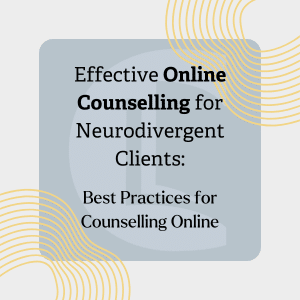Autism-Informed Practice Course
Gain the Knowledge & Skills to Support Autistic Clients with Confidence & Compassion
The following article is taken from our Autism-Informed Practice course.

Gain the Knowledge & Skills to Support Autistic Clients with Confidence & Compassion
As online counselling becomes increasingly prevalent in the therapeutic field, especially post-2020, counsellors must adapt their approaches to better serve neurodivergent clients, specifically those with autism. Recent research, including Howard and Sedgewick’s 2021 study, highlights distinct communication preferences within the autistic community.
These insights will help counsellors and psychotherapists to create a supportive, accessible, and effective therapeutic environment for neurodivergent individuals. This blog post will guide practitioners in understanding these unique needs, identifying preferable communication modes, and optimising online counselling to enhance client engagement and outcomes.

Online Counselling for Neurodivergent Clients
By exploring the insights from this research, practitioners will:
Ken Kelly: We’re talking today specifically about maybe having a counselling session, welcoming a neurodivergent counsellor into an online setting, whether that be online via a video application or via telephone, text, or email. So using technology, what do we need to know? Is it different, Rory?
Rory Lees-Oakes: Yeah, and I think the first thing we have to acknowledge is the rise of the online world since 2020. For those of us who can remember, we had the COVID epidemic, what happened was that online and telephone counselling went from quite a niche activity, to an essential activity through those lockdowns, then it became part of a very mixed economy of offering to clients.
And as we know, online counselling is very different to face to face there are mechanisms, psychological processes and safety aspects. Perhaps something that slid under the radar a little bit in the online world is that people who are neurodivergent may have specific needs to have online and telephone counselling or text-based counselling.
One of the interesting things I found was research by Howard and Sedgwick in 2021.
So relatively new research. And one of the things they came across after speaking with neurodivergent clients in medical settings, was a good proportion of those who are neurodivergent, specifically those with autism, didn’t like using the phone, and found it a barrier to reaching services.
So, a bit of a salutary lesson for those offering online and telephone counselling, for some people, the phone may not be the best medium. And that’s something we really need to take in account when meeting our clients first time on listings or websites, Ken.
Ken Kelly: Thank you, Rory. You started this off by saying, we all know online working. is a specialist area So pre COVID. there was no formal online or technology training in core counselling training.
If you did cover it, it would be just a brief touch on itSo the curriculum has changed to focus on the fact that there is an online element or a technology element. The ethical bodies have adapted their recommendations and their best practice guides for how we should work.
The BACP here in the United Kingdom have issued a curriculum of what you should study what topics and areas you need to understand to be able to work online, it is not the same as face to face. Then you look to invite a neurodivergent audience for that use of that technology in counselling, then there are additional considerations.
I very rarely answer my phone. I let it go through to voicemail, and then I’ll pick up a different form of communication to carry on the conversation with that person. What I don’t like about phone conversation, is the immediacy of it. That person speaks now, and I have to answer immediately. Maybe for this reason, written communication for many neurodivergent clients is a preferred way of communicating. It might be email communication where there is time to think and process before answering. One of those reasonable adjustments might be that if we are communicating via telephone or an online video platform, more time is given for them to think about their answer and come back with what they want to share.
So more pauses might be a reasonable adjustment.We may have neurodivergent clients, and this is not just to applicable to neurodivergent client, this is broader than that. We may have clients who wish not to show themselves on a video platform. They may wish to use an avatar, or they may wish to use a picture of either themselves or just an inanimate object and just work with voice. Now, this can be really helpful for that neurodivergent individual, because they don’t have to try to maintain eye contact.
We’ve spoken about reasonable adjustments in person within the room, where we might turn the chairs away from each other.
If you think about video platforms, most of them will put two passport photos of each other basically side by side. And in a way, you feel that you’re looking into the eyes of that person, and that can feel uncomfortable. Maybe a reasonable adjustment is that it’s okay for that person to turn off their camera.
But that leads to other considerations as well, such as, are they alone in that room? Is there anybody else that can overhear the conversation?
Are they in a safe place? So we would need to think around that, and maybe have that kind of a discussion. The final thought from my side, Rory, is when we do hold online therapy, very often in my experience, you might be seeing a client who is sat down, maybe in a room, maybe on a chair, maybe in an office in a kitchen, but generally they might be sat down looking at maybe a laptop or a phone and interacting in that way.
With a neurodivergent individual, they may feel safer in a dark room. They may feel safer lying down with a blanket over them. If I was your client, and you’d seen me a few times before, and I had not shared that I was neurodivergent, but one day, when we had our meeting online, I was lying in bed, you might have questions around that.
But we would be looking differently if it was a neurodivergent client that we were working with, Rory.
Rory Lees-Oakes: Yes, we have to think about meeting the clients where they are.
It may very well be that when you meet a client online and they’re lying in bed, that might be very uncomfortable for the therapist because this isn’t what we do. We usually turn up and we’re usually sat in seats, we usually look at each other. I think that kind of thinking needs to be reexamined, because some neurodivergent people have a strong reaction to bright lights, so we might see them in dimly lit rooms. It might be there’s a sensory consideration, that the client feels safer if they’re under a blanket.
Now, unless you know how neurodivergent people interact with the world, it can feel a little different as a therapist. But as you say, knowledge is a great thing. Giving the client choice is a strategy to manage, not only their sensory considerations, but also how they feel.
I would think that nowadays those working online may have some kind of conversation within their websites or listings about how they work with neurodivergent clients. Speaking directly to them before you’ve even met the client and say, it may be that you don’t like lights, it may be you prefer not to use the phone, in some situations you may want to have a blanket. It’d be useful for us to talk about this before therapy commences, so I could get a better sense of you. And I think it’s all about making your offer clear to the client and making sure that you understand, as a therapist, their frame of reference.
And eye contact is a classic one because in Western societies, we’re drilled into us for from children. Look at me in the eyes. and i f you don’t look at someone in the eyes, it’s considered untrustworthy. There’s a lot of communities who don’t have eye contact.
I worked with a client who came from Pakistan, and she didn’t like eye contact. It was a big struggle for her because her son was at an English school and teachers always used to say, look me in the eye, and it was quite a challenge. The same thing happens with neurodivergent clients, they find eye contact uncomfortable. It’s about setting your practice up for that diversity, which is, of course, neurodiversity.
And there is more neurodiverse people being recognised now and recognising themselves as neurodiverse than ever before.
Ken Kelly: Indeed, it’s an important topic and it’s recognising the hidden generation of all those people that may have not been diagnosed, and went through their whole life facing all of these challenges, and working in a way that welcomes them into our therapy. And what we’re doing here is we’re building on the formal training foundations, and that’s why I started this by saying, it would be hoped, that at this stage, anybody working online or with remote technology would have done a comprehensive course in working online.
To understand things like the disinhibition effect, or black hole, or the other psychology that plays out online that maybe doesn’t play out in a face to face setting, in the same way as we would not expect that somebody might be counselling a neurodivergent client if they hadn’t gone and trained to become a counsellor. The same way we would hope that then nobody would be counselling a neurodivergent client or any client at all online or using technology if they hadn’t done the training to gain the competences within that area.
So we’re building on our existing training and when we’re looking at neurodivergence, we’re talking about understanding what challenges they may face, how they may show up, what we may see in that, and how we can best welcome them by making reasonable adjustments ourselves with the knowledge that we hold.
One of the areas that is covered extensively in core training to work online or with technology, is managing risk in the online setting. And I wonder, Rory, if you could just touch for a moment on how that would differ if we were managing risk in online counselling for an autistic client.
Rory Lees-Oakes: Yes, the first thing is working online and working in the room are clearly different if you’re working in the room, and someone becomes unwell or says that they may be thinking of taking their own life, they’re in front of you and you can take action.
If someone bluntly has a heart attack, you phone the ambulance up and they come to your practice rooms and medical aid is given. If you’re working with someone online on a video platform, and you don’t know where they are, then it’s very difficult to get medical attention to them.
So making sure that when you work online, you have a contract, and you have contact details, emergency contact details is essential.
But specifically about autistic individuals, there is a lot of research now that says that people are autistic, not all, but a substantial majority have an increased risk of other mental health challenges, including a heightened prevalence of suicide ideation. Which is why we must always think about risk management, and it’s especially critically sharper in our thinking when we’re working with neurodivergent clients.
And the way we do that is to review and clearly outline our contract. That we have safety protocols, contact details, and emergency contact information. Maybe somebody who knows the clients having counselling, so you can contact them if they become unwell, is going to mitigate risk because the risk would seem to be higher with those people who are neurodivergent or on the autistic spectrum, so keeping that very sharply in our mind.
Ken Kelly: Thank you, Rory. That was beautifully outlined. When we’re working with the client online, we’re going to be looking what their support structure is, who they have around them, and we would do that in face to face client as well. You know, mapping a support structure and understanding what that looks like?
It’s important. If you’re working with a neurodivergent individual, within neurodivergence, in ADHD, and certainly in autism, there there can be overwhelm, there can be meltdown where the person appears to become very agitated, very angry almost in a moment or not necessarily anger.
It can be overwhelm, it can be anxiety, but it comes all at one time, and it can seem like it comes from absolutely nowhere.
You would want to already have knowledge of what support structures are in place for that individual. You would want to know what their special interest is, or what the activities are that restore or rejuvenate their points.
So if I was working with a client, and maybe that client gained great comfort from their animal. If I saw them getting really agitated or anxious within the session, I might say, I wonder if the dog is close by and can come and sit with you now?
Or I might say afterwards, you could now go and spend some time with your animal. We’re talking meltdown there. It seems quite implosive, explosive. The shutdown is really the opposite. It’s almost like the person goes mute, they disappear, they go from being interactive within a situation to just being there physically.
We’d be looking to map support systems to understand how that person is as we end that session. Online, we don’t have the luxury of that person being in the room where we can say, are you okay? And we can really check in with them.
So counsellors working with neurodivergent clients must recognise and adapt to diverse communication preferences when prioritising written communication to support unique session environments, if need be, by fostering accommodating and understanding approach practitioners can significantly improve the therapeutic experience of autistic clients.

Howard and Sedgewick’s study underscores a strong aversion to phone communication among autistic clients, primarily due to the demands on auditory processing.
Autistic clients often experience difficulty processing verbal information in real time, which can lead to cognitive overload. The quick pace of phone conversations can exacerbate this challenge, leaving clients feeling anxious or misunderstood. For therapists, this insight suggests that alternatives to phone counselling may be essential for effectively engaging neurodivergent clients.
Consider video, text-based, or asynchronous methods instead of phone sessions. These allow clients the processing time they need without the added auditory demands of phone communication.
The study found a pronounced preference among autistic clients for written communication modes such as email or text. Written communication allows clients greater “thinking time,” provides structured interaction, and reduces sensory overload. These factors make email, text, or other written formats ideal for clients who benefit from processing information at their own pace.

Incorporate options for written communication within your service offerings. For example, offer email check-ins or text message options as an addition to live sessions. However, ensure that written exchanges are clear, contextually relevant, and structured to accommodate the asynchronous nature of this communication mode.
While video-based therapy is generally more effective than phone calls for autistic clients, adapting video session protocols to respect client preferences is crucial. For example, some clients may prefer not to show their faces on screen or feel more comfortable engaging from a secure location, such as lying in bed. Such preferences can be linked to sensory needs and comfort, which are particularly relevant for neurodivergent individuals.
Encourage clients to communicate their preferences, whether turning off their video feed or choosing a comfortable setting for their session. Recognising and supporting these choices encourages trust and enables clients to fully engage in therapy without compromising comfort.
The “disinhibition effect,” common in online settings, refers to individuals feeling less constrained by typical social norms, potentially affecting their behaviour in therapy sessions. For autistic clients, this might mean they feel more comfortable engaging in therapy from unconventional locations or in unique settings (e.g. in bed, in a dimly lit room, or under a weighted blanket). Far from indicating a lack of seriousness, these choices may reflect their strategies for sensory management.
Counsellors should view these choices without judgement, understanding that they may serve as coping mechanisms. A non-judgemental approach to acknowledging these preferences is essential for building rapport and facilitating a supportive environment.
Research shows that autistic individuals face an increased risk of mental health challenges, including a heightened prevalence of suicidal ideation. This makes risk management especially critical when working with neurodivergent clients. Reviewing and clearly outlining an online counselling contract that specifies safety protocols, contact details, and emergency contact information is recommended.
Ensure that clients and their families understand the emergency procedures if immediate assistance is required. Regularly revisiting this information and updating contact details as needed will help mitigate risks and ensure that both client and therapist are prepared for any urgent situations.
Effective Online Counselling for Neurodivergent Clients – Best Practices for Counselling Online
Counsellors working with neurodivergent clients online must recognise and adapt to diverse communication preferences, from prioritising written communication to supporting unique session environments. By having an accommodating and understanding approach, practitioners can significantly improve the therapeutic experiences of autistic clients. Adapting to these needs requires flexibility, sensitivity, and a commitment to ongoing learning.
This approach aims to empower practitioners to deliver effective and empathetic online therapy tailored to the unique needs of neurodivergent clients, ultimately contributing to a more inclusive and supportive therapeutic landscape.
Autistica. (n.d.). Suicide and Autism. Autistica. Available at Autistica
Howard, P.L., & Sedgewick, F. (2021). “Anything But the Phone!”: Communication Mode Preferences in the Autism Community. Sage Journals. Available at Sage Journals
Nicholson, E. (2016). What Works When Counselling Autistic Clients? Healthcare Counselling and Psychotherapy Journal.
Notice any broken link or issues with this resource? Kindly let us know by email
Email us